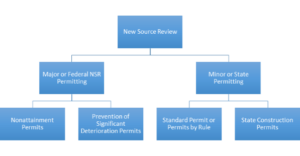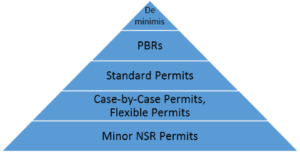TCEQ Air Quality 101 Blog Series – NSR Permitting
Posted: June 6th, 2017
Authors: Frank D.
In late March, I had the opportunity to participate in an event called the Texas Independence Relay (TIR), which is a 2-day, 10-person running event from Gonzales through Houston, covering 200 miles from start to finish. The relay commemorates the independence of the State of Texas and the race appropriately ends at the San Jacinto Monument, which is dedicated to those who fought at the Battle of San Jacinto (for those not from Texas, you might need to brush up on your history). As our team entered the final stretch of our race, we ran through Pasadena and Deer Park with the Ship Channel facilities in eyesight and the Texas sun overhead. During this time, I couldn’t help but don my air quality consulting cap—to shade myself from the sun, of course—and let my mind wander through the complexities of the Texas Commission on Environmental Quality (TCEQ) New Source Review (NSR) Permitting that facilities, such as those I was passing, are potentially subject to.
TCEQ permitting, just like other state permitting programs, includes many nuances and unique requirements. When I first began to work on TCEQ air permitting projects, I stumbled upon TCEQ’s very helpful online air permitting training course. While the training course provides a broad overview of air permitting topics, I found that it would be beneficial for me and others, who want a quick snapshot of TCEQ air permitting, to have a cheat sheet that summarizes air permitting options in Texas, hence this blog. Be on the lookout for similar blogs that are part of ALL4’s Houston Office series focused on providing information related to TCEQ-specific air quality rules and regulations.
TCEQ Permitting Basics
Let’s start off with the basics. With authority from the Texas Clean Air Act (TCAA), the TCEQ manages the air quality in the state of Texas by regulating the release of air contaminants and administers the air quality permitting program. Air permitting in Texas can be broken down into two main categories as presented in the following flow chart, Figure 1. The main categories are major (also referred to as Federal) NSR and minor NSR (also referred to as state) permitting. Each category can then be further divided based on different permitting programs. For this discussion we are focusing on the right side of the chart: Minor or State Permitting. Understanding this flowchart is key when planning a project in Texas.
Figure 1: Federal and State NSR Permitting Flow Chart
Defining the Project and What Permit You Need
The first step of any potential project is to evaluate the project-related actual or potential emissions from new or modified equipment. How the project impacts other facility operations and emissions units must also be considered. In most cases, the initial project construction can only commence if the permittee has an air quality permit in hand, hence the importance of an air permit application being correct and complete the first time. Therefore, budgeting enough time to get an air permit when considering a capital project is critical. Once the potential or actual emissions have been quantified, the appropriate permitting applicability, or exemption can then be determined.
TCEQ authorizes Major NSR Permits (i.e., case-by-case for major sources), Minor NSR Permits (i.e., case-by-case for minor sources), Flexible Permits, Standard Permits, and permit by rules (PBRs). For sources and facilities that satisfy the de minimis rule requirements, those sources and facilities do not require an additional authorization permit prior to construction. Figure 2, depicts a breakdown of minor NSR permitting and exemption options in Texas. As the pyramid blocks increase in size, so too does the complexity of each permitting option.
Figure 2: TCEQ Air Permits Division Permitting Options Breakdown
De Minimis
A new or existing source may satisfy the requirements for a de minimis facility under 30 TAC §116.119. De minimis activities include small increases to background concentrations of air pollutants that would not cause a discernable impact on public health. Specifically, if a facility meets the de minimis criteria as described in 30 TAC §§116.119(a)(1)-(4), and if a facility maintains appropriate records that demonstrate the de minimis rule requirements are being satisfied, no other state authorization is required.
PBR
For those facilities or activities that have been deemed insignificant by the TCEQ, these facilities may be “permitted by rule”. Specifically, PBRs are standard permits for a population of source types that do not make a significant contribution of air contaminants to the atmosphere. Facilities must meet the exact requirements of a PBR for a PBR to become authorized. There are over 100 individual PBRs codified in 30 TAC §106. Facilities claiming PBRs must meet a series of general and recordkeeping requirements in 30 TAC §106.4 and 30 TAC §106.8, respectively. The facilities must also meet the specific requirements listed for each individual PBR citation/category. PBRs are not required to be renewed and merely require the facility to demonstrate continuous compliance with each PBR through recordkeeping and work practice standard requirements. Changes to the facility or source can be completed as long as the conditions of the PBR are still met. Costs vary for PBRs, but are no more than $450. The TCEQ target review time for PBRs is about 45 days. If your facility is considering a PBR, ALL4 recommends scheduling a meeting with TCEQ to confirm concurrence with the PBR category. Establishing a direct line of communication with TCEQ regarding your project is always a good practice regardless of permitting category your project falls into. Additionally, it should be noted that several Texas permitting programs offer expedited options as well as electronic submittal options.
Standard Permits
Similar to PBRs, standards permits specify a set of pre-determined requirements. Standard permits are intended for well-characterized classes of facilities and are typically used for sources with higher emissions than those authorized by a PBR. Standard permits are codified in 30 TAC §116, Subchapter F and offer an efficient mechanism for qualifying facilities to acquire authorization in lieu of permitting through a case-by-case air quality permit. A review of a standard permit application ranges from 45 to 60 days, requires a $900 application fee, and does not require public notice.
Minor NSR Permits
Sources that do not trigger major source permitting, and don’t fit into the aforementioned categories, may be subject to minor NSR permitting. Minor NSR permitting in TCEQ involves permitting on a case-by-case basis and can be broken out into two different permit types:
Case-by-Case Permits
Case-by-case permits are codified in 30 TAC §116 and are intended for more complex facilities and sources. This NSR permit process requires applicants to negotiate the best available control technology (BACT) and emissions limits. The permittee must demonstrate compliance with off-property health impacts due to the project emissions. An air quality impacts analysis may be required to demonstrate that a proposed facility will comply with the intent of the TCAA and the applicable federal and state rules and regulations. TCEQ’s Air Quality Modeling Guidelines (found here) provides more information regarding how to conduct off-property health impacts. While atmospheric dispersion modeling may ultimately be required, sources should not conduct modeling without first having a conversation with the corresponding TCEQ air permits division staff. Case-by-case review for a new construction can take 285 days or more. The case-by-case permit application fee depends on the project capital cost and proposed permits require public notice. Once issued, case-by-case permits consist of special conditions and the maximum allowable emission rate table (MAERT). A MAERT includes allowable emissions rates on an hourly and annual basis that have been established by a permit for a facility. A MAERT typically includes the potential to emit (PTE) for units at the facility.
Readily Available Permits or RAP provide another case-by-case permitting option. Refer to my historic blog, or the TCEQ presentation on RAPs at their Advanced Air Permitting Seminar for more information on how RAPs can be used as an efficient way to streamline an NSR permit application.
Flexible Permit
As an alternative to a case-by-case permit, a facility may obtain a flexible permit, which allows for physical operational changes as provided under 30 TAC §116, Subchapter G.· Flexible permits are valid state permits that require BACT and were designed to create an emissions cap by pollutant for facilities. This type of permit grants a facility more flexibility, as the facility manages compliance with a facility-wide cap, instead of managing individual emissions limits. A facility may structure the emissions cap to better serve the production needs of the facility.
Do the TCEQ air quality rules and TCEQ permitting program have you confused? Are you looking for your air quality permit application to be completed correctly the first time? Are you too busy tending to the daily operations of your facility? Well, ALL4 has you covered. ALL4 delivers permitting applications on time and on budget, and acts as a liaison between clients and TCEQ on important projects. Please reach out to me at fdougherty@all4inc.com, 281.937.7553 x302 if you have any TCEQ permitting questions or want to talk about air permitting support for your project.



